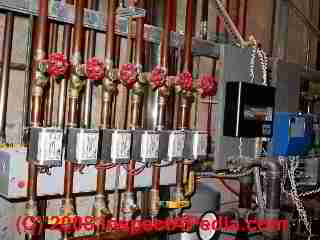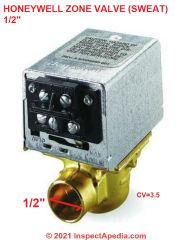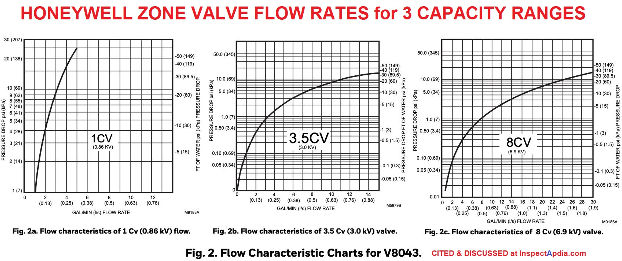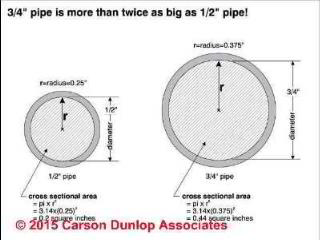 Heating Zone Valve Flow Rates
Heating Zone Valve Flow Rates
Effect of zone valve pipe diameter on heat delivery
- POST a QUESTION or COMMENT about hydronic heat zone valve capacities & flow rates.
This article describes the flow rates and gpm delivery capacity of hot water by heating system zone valves.
Page top photo: a bank of six heating zone valves each controlling a separate heating zone in a New York home. Usually these valves and heating zones are piped in 3/4" copper.
InspectAPedia tolerates no conflicts of interest. We have no relationship with advertisers, products, or services discussed at this website.
- Daniel Friedman, Publisher/Editor/Author - See WHO ARE WE?
Heating Zone Valve Size Impact on Heat Delivery
 Question: the effect on heat delivery if we install a smaller-diameter zone valve on a hot water or hydronic heating system.
Question: the effect on heat delivery if we install a smaller-diameter zone valve on a hot water or hydronic heating system.
ac godbout
We live in a condo, our zone valve was changed recently and reduced from 3/4 to 1/2, what effect will that have on heating in colder temperature like -35degrees Celcius - 2021/11/10
This Q&A were posted originally
at HEATING SYSTEMS - home
Photo at left: Honeywell (TM) 1/2" diameter sweat-type zone valve.
[Click to enlarge any image]
Moderator reply: 0.2% reduction in typical zone valve gpm flow rate
Thanks that's a helpful question: the effect on heat delivery if we install a smaller-diameter zone valve on a hot water or hydronic heating system.
Bottom line: there will be no noticeable difference between the heating water flow rate through a 3/4" zone valve and a 1/2" zone valve, if we simply take as an example the Flow Capacity (Cv) ratings given for each of those products (illustrated above).
Both the Honeywell 1/2" sweat-fitting zone valve (#V8043E1004) and the Honeywell 3/4" sweat-fitting zone valve (#V8043F1036) have identical Flow Capacity (Cv) ratings of 3.5 according to the manufacturer's literature.
FYI Flow Capacity or Cv is defined as
the volume of water at 60°F (in US gallons) that will flow through a valve per minute with a pressure drop of 1 psi across the valve.
Below in a fancier calculation I set out to demonstrate why the two valves can deliver essentially the same heat rate in gpm or BTUs.
The Flow Characteristic Cv Charts shown below give data for three different zone valve settings or capacities, at Cv's of 1, 3.5 and 8, excerpted from the Honeywell zone valve installation instructions cited at the end of this article. 3.5 Cv is the standard rating for these zone valves.
[Click to enlarge the Cv chart shown below.]
Details: how does pipe diameter affect the flow of heating water or heat delivery?
You will want to take a look at
WATER SUPPLY PIPE DIAMETER vs FLOW
where we argue that changing pipe diameter in any water flow system does have some effect, potentially significant, on flow rate.
On that page we give some data
- Nominal 1/2” K Copper: OD: 0.625” ID: 0.527” Wall: 0.49” Cross-Sectional Area: 0.218”
- Nominal 3/4” K Copper: OD: 0.875” ID: 0.745” Wall: 0.65” Cross-Sectional Area: 0.436”
But if ONLY the zone valve diameter was reduced from 3/4" to 1/2" - that's just about 3-4 linear inches of piping, in our OPINION you won't be able to detect the reduction in heating water flow nor BTU delivery to the occupied space .
That's because the impact on flow rate is small until the linear feet of change in pipe diameter is quite a bit more than 3-4 linear inches.
Calculate the Flow Restriction When Changing from a 3/4" to 1/2" Zone Valve
Here's an example using PEX tubing: (I know yours is probably copper but this is just data that we already had and that allows a clear example)
- 1/2” PEX has a pressure drop of 1.70 gpm per 100 ft. of run
- 3/4” PEX has a pressure drop of 0.34 gpm per 100 ft. of run.
So while the pressure drop is significant when the diameter of piping gets smaller, notice that it's per 100 ft. of run.
Going from 3/4" to 1/2" gives us a drop of 1.36 gpm over 100 ft.
Now if we calculate the pressure drop over 4 inches: I make that to be
(4/1200) x 1.36 = 0.0045 gpm reduction in flow rate - or really really tiny.
A typical hydronic heating circulator pump like a Taco 007-F5, at 1 ft. of head, pumps at about 22 gpm.
So your reduction in gpm would be
0.0045 / 22 = 0.002 or about 0.2% reduction in the gpm delivery rate of hot water through your heating baseboards or radiators - not much, right?
Ask your heating service company if they have a different way to calculate the effect we're describing.
Watch out: Reducing large lengths of heating pipe in diameter can make a significant reduction in the rate of heat delivery in the building.
Illustration courtesy of Carson Dunlop Associates, a Toronto home inspection, education, and report writing tool firm.
Heating Zone Valve Capacity References & Research
- CALEFFI ZONE VALVE INSTALLATION GUIDE [PDF] (2017) for Caleffi Z-One Zone Valves, Caleffi North America, Inc., Email: sales@caleffi.com Web: www.caleffi.com
- HONEYWELL 1/2" & 3/4" SWEAT ZONE VALVE PRODUCT SPECIFICATIONS [PDF] for V4043A,B,E,J; V4044A,B; V8043A,B,E,F,J; V8044A,B,E Motorized Valves
- HONEYWELL V8043C,D,F & G
Motorized Zone Valves INSTALLATION INSTRUCTIONS [PDF] (2020) Resideo Technologies, Inc.
1985 Douglas Drive North, Golden Valley, MN 55422
1-800-468-1502
95C-10926EF—04 M.S. Rev. 04-20| Imprimé aux États-Unis
Excerpt:
The V8043 Motorized Zone Valve provides two-position (open-close) control of supply water for baseboard radiation, convectors, fan-coil units, etc. It uses a two-wire, 24-volt control circuit and requires a SPST thermostat. Integral end-switch models permit the sequencing of auxiliary equipment. - Flick, Mike, WHAT is VALVE FLOW COEFFICIENT (Cv) [PDF] Kimray Sales & Service
19396 Kenswick Building B
Humble, TX 77338
(936) 441-2468 HQ Corporate: (405) 525-6601
US Customer Service: (405) 525-4298 or service@kimray.com
International Customer Service: intlservice@kimray.com
Product Support: (405) 525-4264 or prodtechsupport@kimray.com retrieved 2021/11/10 original source: https://kimray.com/training/what-valve-flow-coefficient-cv#:~:text=Valve%20Flow%20Coefficient%20(Cv)%20is,1%20psi%20across%20the%20valve.%E2%80%9D
Excerpt:
Definition: Valve Flow Coefficient (Cv) is a valve's capacity for a liquid or gas to flow through it.
It is technically defined as “the volume of water at 60°F (in US gallons) that will flow through a valve per minute with a pressure drop of 1 psi across the valve.”
...
Continue reading at ZONE VALVES, HEATING, or select a topic from the closely-related articles below, or see the complete ARTICLE INDEX.
Or see these
Recommended Articles
- AIRBOUND HEAT SYSTEM REPAIR by WATER FEED VALVE if your heating zones don't get hot even though the zone valve opens, the circulator runs, and the boiler heats.
- CIRCULATOR PUMPS & RELAYS
- DIAGNOSE & FIX HEATING PROBLEMS-BOILER - home
- DISSOLVED OXYGEN DAMAGE CONTROL
- MANUALS for HEATING & A/C SYSTEM CONTROLS
- RADIATOR & ZONE CONTROL MANUALS
- THERMOSTATS, HEATING / COOLING
- WATER SUPPLY PIPE DIAMETER vs FLOW
- ZONE CONTROLLER TACO ZVC403
- ZONE VALVES, HEATING - home
- ZONE VALVE BANGING or BACKWARDS
- ZONE VALVE MANUALS & WIRING INDEX
- ZONE VALVE SIZE vs GPM
Suggested citation for this web page
ZONE VALVE SIZE vs GPM at InspectApedia.com - online encyclopedia of building & environmental inspection, testing, diagnosis, repair, & problem prevention advice.
Or see this
INDEX to RELATED ARTICLES: ARTICLE INDEX to HEATING SYSTEMS
Or use the SEARCH BOX found below to Ask a Question or Search InspectApedia
Ask a Question or Search InspectApedia
Try the search box just below, or if you prefer, post a question or comment in the Comments box below and we will respond promptly.
Search the InspectApedia website
Note: appearance of your Comment below may be delayed: if your comment contains an image, photograph, web link, or text that looks to the software as if it might be a web link, your posting will appear after it has been approved by a moderator. Apologies for the delay.
Only one image can be added per comment but you can post as many comments, and therefore images, as you like.
You will not receive a notification when a response to your question has been posted.
Please bookmark this page to make it easy for you to check back for our response.
IF above you see "Comment Form is loading comments..." then COMMENT BOX - countable.ca / bawkbox.com IS NOT WORKING.
In any case you are welcome to send an email directly to us at InspectApedia.com at editor@inspectApedia.com
We'll reply to you directly. Please help us help you by noting, in your email, the URL of the InspectApedia page where you wanted to comment.
Citations & References
In addition to any citations in the article above, a full list is available on request.
- In addition to citations & references found in this article, see the research citations given at the end of the related articles found at our suggested
CONTINUE READING or RECOMMENDED ARTICLES.
- Carson, Dunlop & Associates Ltd., 120 Carlton Street Suite 407, Toronto ON M5A 4K2. Tel: (416) 964-9415 1-800-268-7070 Email: info@carsondunlop.com. Alan Carson is a past president of ASHI, the American Society of Home Inspectors.
Thanks to Alan Carson and Bob Dunlop, for permission for InspectAPedia to use text excerpts from The HOME REFERENCE BOOK - the Encyclopedia of Homes and to use illustrations from The ILLUSTRATED HOME .
Carson Dunlop Associates provides extensive home inspection education and report writing material. In gratitude we provide links to tsome Carson Dunlop Associates products and services.




